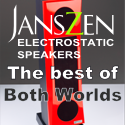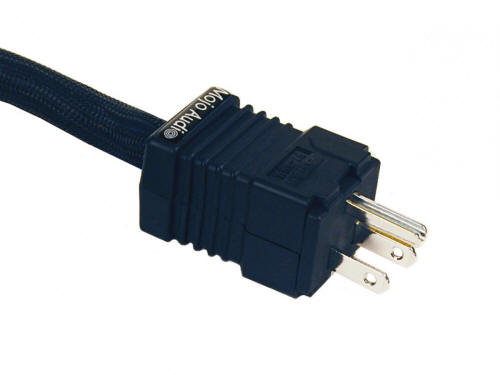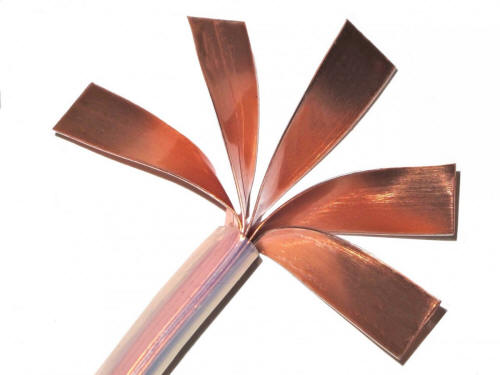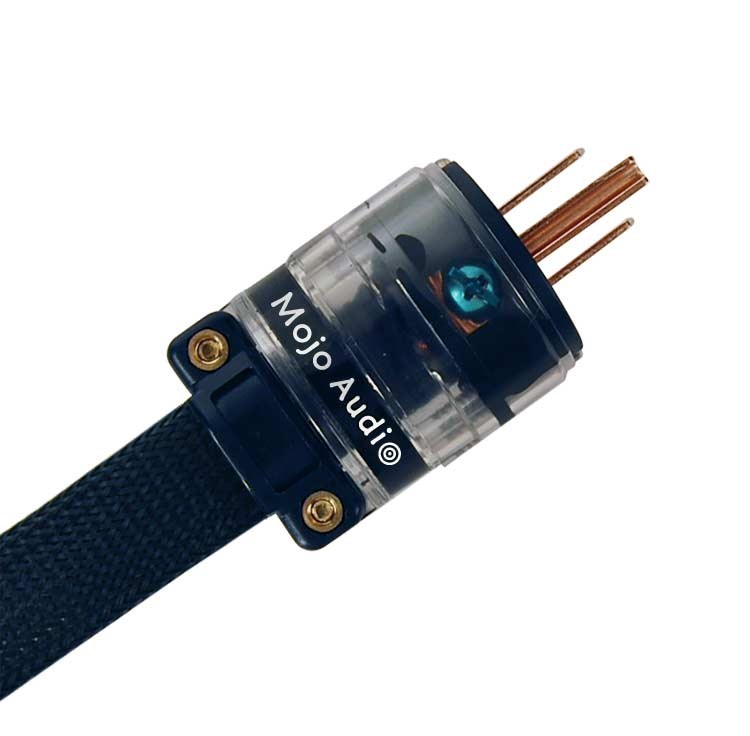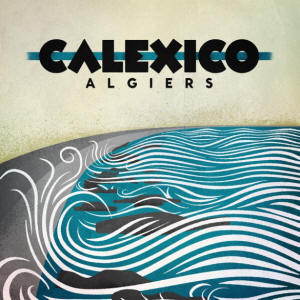|
|
You are reading the older HTML site
Positive Feedback ISSUE 64
mojo audio Enigma and XPC-7 Power Cords as reviewed by Andre Marc
Mojo Audio was new to me until I received an email from our esteemed editor if I was interested in taking a look at their product line. The line included a NOS DAC, a music server, analog signal cables, digital cables, and power cords. I was intrigued. The company sells direct from its website, and is also a Furutech dealer. The company is based in Pittsburgh, PA. It was decided I would review some Mojo power cords, as several other products were spoken for. I received at my doorstep three 1.5 Meter length cables including the XPC-7, starting at $499.95, and two variations on the Enigma, starting at $299.95. The cords arrived well packed, but without fancy velvet bags, or unnecessary packaging. Mojo believes this is money wasted, and customers would prefer not to subsidize this kind of approach. I totally agree. It is ultimately a huge waste of paper and plastic, and adds to the cost of the cables. Now, let's get a few things out of the way. First, power cords DO make a difference. Regardless of all the bitter debate and naysayers, they just do. This is coming from a major skeptic, of most things in life in general. When I bought my first high end system several years ago which consisted of Audio Research and Naim electronics, I was perfectly happy with the stock power cords. I did however have audiophile friends whispering in my ear about how I could improve the performance of the system with aftermarket power cords. After looking at the prices of some of these cords, which to me were nothing but copper and plastic, I hesitated. Ultimately I took home a few Acoustic Zen Tsunami II cords to audition. Well... I was astonished that a power cable could change the sound of my preamplifier and power amplifier, but they did. Specifically, there was more music, more nuances, and less grunge. Why do AC cables make a difference? I am NO engineer, and I don't play one on television. I am about the least technical reviewer around. However, I do like to know why and how things work. Based on reading a lot comments by various cable designers, my own simple theory is that good power cables are superior to cheap stock cables in several categories. First and maybe most obviously, is the use of high grade materials and plugs, which offer, protection from RFI/EMI entering the power supply. Various noise rejecting geometries and shielding are used in this regard as well. Secondly, better designed cords offer more consistent current delivery, which is important for dynamic swings. Lastly, better engineered cords allow for significantly less voltage drop, which might allow the power supply to work less hard, so to speak. Again, this is my simplistic overview. Some cable manufacturers also tout the use of cryogenic treatments, exotic conductor materials, and virgin sacrifices as well. Just kidding on the sacrifices. But it is true that some manufacturers bestow gothic and mythological names on their products, and take space ads that declare their cords have mystical powers. Many dress their cables in ostentatious outer jackets, and shrink wrap their connectors for affect, which in the end, do not add to performance, but, again, do add to cost. The loom of Mojo power cords I received were configured as follows: The XPC-7 was terminated with a Furutech F-11 CU plug, one Enigma was terminated with a Furutech rhodium plated copper square FI-15 plug, and the other Enigma with a unidentified "Red Copper" plug that was very impressive in build quality. I should note that according to Mojo, The FI-15 "shares the same "best" metallurgy as Furutech's flagship FI-50 plugs as well as the same proprietary cryo/demag "Alpha" treatment". I installed the cables using the XPC-7 on amplifiers, the Red Copper Enigma on preamps, and the Fl-15 Enigma on my DAC. I can't emphasize enough the quality of the connectors and terminations. Furutech's stellar reputation is much deserved. Benjamin Zwickel, Mojo Audio's head honcho emphasized that the cable benefitted from extensive break in/burn in. I mean extensive. He said 100 hours just gets them going, 300 hours gets you a good way there, and he claims they improve well beyond that. See my interview with Benjamin at the conclusion of this review. All my serious listening was done with at least 100 hours on the cable, and much of it with 300 hours. I leave all solid state equipment powered up for maximum performance, and my entire main system is plugged into an Audience Adept Response aR6 power conditioner.
The XPC-7 is a ribbon cable, by the way. According to Mojo technical description, "each conductor is constructed from seven 14AWG high-purity OFC copper ribbons stacked one on top of the other. Each ribbon is coated with a thermo-bonded microdielectric, minimizing dielectric absorption. The bundle of stacked ribbons floats in an air dielectric inside of a laboratory-grade PTFE Teflon tube." I used it on three separate power amplifiers including the stellar Densen B-310, my Audio Research VS55, and the new Onkyo M-5000R.
The Enigma with the Furutech square bodied Fl-15 plug was used on my Bryston DAC, and the Enigma with the Red Copper plug was used with solid state Densen B-200, Onkyo P-3000R preamps, and with a tubed Audio Research SP-16L. According to Mojo, the Enigma series has been upgraded and improved for 2012. Improvements and changes include a new dielectric developed with Kimber Kable, cryogenic treatment, and a custom variation on Kimber's Varistrand geometry. High purity copper is used throughout. My current power cables include the aforementioned Acoustic Zen Tsunami II, a Transparent High Performance PowerLink, a few Shunyata Venoms, an Element Cable ElementCord and Red Storm, and a DH Labs Encore. My Audience power conditioner has a Neutrik tethered Audience power cord as well. The entire system is routed through the conditioner, which is plugged into a dedicated 20 amp line, via an Oyaide AC receptacle. After sitting down for some serious listening, post 100 hours, I could see, or rather hear, I was dealing with some excellent products here. Let me go on record here in that I don't personally believe power cords have any sonic signature of their own, meaning they have no inherent bass, midrange, and treble characteristics. What do they DO have the ability to do is interact with a component's power supply to allow it to perform at its best, with the lowest possible noise factor, and consistent, high quality voltage delivery. This is my view. Having said that, the Mojo cords worked really well with all the components I used them on. The power amps, preamps, and sources all performed the best I had heard them.
Specifically, well recorded acoustic music was magical sounding. I was enjoying natural sounding textures and timbres on piano, bass, and percussion. Music with tons of dynamics like Rush's new masterwork, Clockwork Angels (24/96 HDTracks download) sounded huge, with maximum impact and drive. Calexico's excellent new release, Algiers, (24/88.2 HDTracks download) really played to the Mojo cables strengths. Backgrounds during delicate quiet passages were ultra quiet, and again, dynamics were effortless, and instruments and voices were palpably present. Quite stunning actually. Conclusion Mojo Audio really impressed me with the craftsmanship and performance of their power cords. Both variants of the Enigma and the ribbon XPC-7 cords are competitive with cords costing many times as much, in my opinion. Mojo offers a very, very generous in home audition policy, measured by any standard. They offer a 45 day trial with no hassle returns. That is tough to beat. I would venture to guess not a lot of cables come back to Mojo at the end of the trial period. There is no magic here, just high quality workmanship, ultra pure metallurgy, carefully chosen materials, and top shelf connectors. An audition is highly recommended. Andre Marc
Enigma Power Cables
XPC-7 Ribbon Power Cable
Mojo Audio Interview with Benjamin Zwickel of Mojo Audio Andre Marc: Can you tell us about how Mojo Audio got started and give us an overview of your current product line? Benjamin Zwickel: For decades, DIY audio had been a hobby of mine, starting when I modded my first Dynaco ST70 in college. Before founding Mojo Audio, I had been a consultant in computerized automated manufacturing and had my own computerized embroidery business. So technology, business, and manufacturing are nothing new to me. Mojo Audio was more fate than intention. When I went back to college to get a degree in Computer Electronics Engineering Technology I needed some cash, so I began to sell off some of my personal stash of rare vintage parts on eBay. When I listed my NOS Western Electric power cables, I was as surprised as anyone by the overwhelming response. I saw the same encouraging response when I began offering audiophile upgrades to vintage CD players. Next thing you know, I was selling all over the world and Mojo Audio was born. With the introduction of our Enigma Power Cable in early 2011, we discontinued the NOS Western Electric power cables that put Mojo Audio on the map. Since its introduction, our Enigma Power Cable has evolved quite a bit. The 2012 version you're reviewing has a new dielectric, twice as much shielding, and an upgraded entry-level plug set with cryo'd red copper contacts and a machined aluminum plug case. Our popular XPC Ribbon Power Cables and Lucent Ribbon Interconnects have evolved quite a bit as well. In 2011, we upgraded our Lucent interconnects to include Furutech connectors. And in 2012, we upgraded our XPC power cables, exclusively using Furutech plug sets. Since the fall of 2009, we stopped doing upgrades to other company's components and began designing and manufacturing our non-oversampling R-2R multi-bit AD1865 DAC. At Rocky Mountain Audio Fest 2012, we introduced the latest version of our DAC. We call it the "Mystique," and it has six dedicated power supplies and a pure tube output stage (no op amps). In early 2010, one of our DAC customers introduced us to computer-based audio. It didn't take long before we were manufacturing ultralow-noise linear power supplies for digital components, including our Apple Mac Mini-based media servers. In 2013, we'll be releasing our next gen Mac Mini Media Server with our Joule III Power Supply as well as our new Joule ATX Power Supply, which can be used with any ATX-compatible computer. I've always told customers, "If it doesn't come out of your source, it can never come out of your speakers." For this reason, Mojo Audio has been focusing and will continue to focus much of our R&D effort on digital source components. Andre Marc: Can you tell our readers your basic design philosophy with respect to signal cables and power cords? Can you also comment on the relationship between power cords and a system's overall performance? Benjamin Zwickel: One important difference between Mojo Audio products and many on the market is our neutrality. Our goal is to create the most transparent conduit for power and signal, not to enhance certain audiophile characteristics to make our products more marketable. Another important difference is that we don't have a "product line" with similar products at different price points. Unlike many companies, we sell only our best concepts rather than creating a false cost-performance marketing ploy with products engineered for targeted price points. As for why our cables are such a good value and perform better than most, it has a lot to do with simple common sense and following the basic rules of electronics. We use only the highest-quality components made by industry leaders, such as Furutech, Kimber Kable, and Bridgeport Magnetics. Many of the concepts we use for shielding and grounding have been used by the military and aerospace industries for decades. One example is the floating shield and external ground wire schema we use for all of our power cables. Unlike most power cable manufacturers, we don't group the ground wire together with the hot and neutral wires and then surround them with a shield. Doing this makes about as much sense as taking a bath in toxic waste and putting a hazmat suit on over top. How much difference can a power cable make? There's been some controversy about this, but let's accept the premise that when it comes to high-end audio, everything matters. However, there's a hierarchy: some things matter more than others. In any component, the sophistication of the power supply largely determines the quality of the sound reproduction. Upgrading power cables or adding an AC power conditioner will make more of a difference with some components mostly because of deficiencies in their power supply. On components that have good power supplies, cables and conditioners will still make a difference, but not as great a difference. This is why we've often heard professionals in the recording industry say that power cables don't matter. As a rule, their pro audio gear has more sophisticated power supplies than most audiophile components. Plus, recording studios use all dedicated AC lines and grounding. We strongly recommend that audiophile hobbyists invest a modest amount on dedicated AC lines and grounding before they spend any significant amount on power cables or AC power conditioners. Let me try to explain how power cables can make a noticeable sonic difference. The quality and type of wire used, the dielectric material surrounding the wire, the geometry of the wire and shielding, and the quality of the plugs, receptacles, and IECs all influence how the resistive, capacitive, and inductive forces affect AC current between the receptacle and the component. To minimize resistance, contacts in AC connectors need both highly conductive metallurgy and a large contact area at the connection. Since brass has only about 35 percent the conductivity of copper, and gold plating has only about 65 percent the conductivity of copper, we've found that brass and gold make power cables sound slow and soft. For this reason, we use only the highest-quality pure copper contacts or sophisticated plated metallurgy made by industry leaders, like Furutech. Power cables are run close to the electronics and speakers, which subjects them to more electrical and mechanical influences than the shielded wires inside the walls. This is what makes grounding, shielding, and mechanical resonance control so important. When multiple devices are plugged into the same AC circuit, each component introduces noise into that circuit. Isolating the grounding and shielding, as we do with all our power cables, decouples the components and minimizes the negative effect one component can have on another. Andre Marc: Finally, is there anything in your mind in the raw materials or construction that can justify cables offered by some designers costing as much as $35,000? Benjamin Zwickel: Unless these companies are using huge amounts of precious metals, like solid gold wire, or rare materials, like carbon nano tubes, the only justification for selling cables for $3500 (let alone $35,000) IMHO would be good old-fashioned greed. The difference in construction and raw material costs between most cables—whether they retail for $200 or $2000—is typically negligible. Often, companies spend a lot to enhance packaging and aesthetics on expensive cables, but they spend little on design and engineering that affect actual performance. At Mojo Audio, we strive to develop affordable, high-performance cables. And we're always making improvements to our products. From year to year, we simply offer our newer, better version and discontinue the old model. That's why we have so few products in our product line. And the prices stay consistent because there are usually only small differences in manufacturing costs. Considering that so many customers and professional reviewers say that our cables sound better than anything that sells for several times the price, I believe we're accomplishing our goals. In addition to what is listed in the system sidebar above, I also had in house the following: Review System 1
CD
Transport: Musical Fidelity M1 CDT Review System 2
CD
Player: Marantz 5003
|

